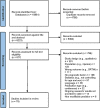Systematic review and tools appraisal of prognostic factors of return to work in workers on sick leave due to musculoskeletal and common mental disorders
- PMID: 39018306
- PMCID: PMC11253986
- DOI: 10.1371/journal.pone.0307284
Systematic review and tools appraisal of prognostic factors of return to work in workers on sick leave due to musculoskeletal and common mental disorders
Abstract
With the overall objective of providing implication for clinical and research practices regarding the identification and measurement of modifiable predicting factors for return to work (RTW) in people with musculoskeletal disorders (MSDs) and common mental disorders (CMDs), this study 1) systematically examined and synthetized the research evidence available in the literature on the topic, and 2) critically evaluated the tools used to measure each identified factor. A systematic search of prognostic studies was conducted, considering four groups of keywords: 1) population (i.e., MSDs or CMDs), 2) study design (prospective), 3) modifiable factors, 4) outcomes of interest (i.e., RTW). Studies showing high risk of bias were eliminated. Tools used to measure prognostic factors were assessed using psychometric and usability criteria. From the 78 studies that met inclusion criteria, 19 (for MSDs) and 5 (for CMDs) factors reaching moderate or strong evidence were extracted. These factors included work accommodations, RTW expectations, job demands (physical), job demands (psychological), job strain, work ability, RTW self-efficacy, expectations of recovery, locus of control, referred pain (back pain), activities as assessed with disability questionnaires, pain catastrophizing, coping strategies, fears, illness behaviours, mental vitality, a positive health change, sleep quality, and participation. Measurement tools ranged from single-item tools to multi-item standardized questionnaires or subscales. The former generally showed low psychometric properties but excellent usability, whereas the later showed good to excellent psychometric properties and variable usability. The rigorous approach to the selection of eligible studies allowed the identification of a relatively small set of prognostic factors, but with a higher level of certainty. For each factor, the present tool assessment allows an informed choice to balance psychometric and usability criteria.
Copyright: © 2024 Villotti et al. This is an open access article distributed under the terms of the Creative Commons Attribution License, which permits unrestricted use, distribution, and reproduction in any medium, provided the original author and source are credited.
Conflict of interest statement
The authors have declared that no competing interests exist.
Figures



References
-
- Corbière M, Villotti P, Pachoud B. Chapitre 12. Maintien en emploi avec un trouble psychique. Une synthèse des écrits. Psychologie et carrières. Louvain-la-Neuve: De Boeck Supérieur; 2022. p. 221–40.
-
- Bellotti L, Zaniboni S, Langlois I, Villotti P. 6 Age, Mental Disorders and Work Design Factors. In: Joy B, Sophie H, Mukta K, editors. De Gruyter Handbook of Disability and Management. Berlin, Boston: De Gruyter; 2023. p. 105–24.
-
- Cieza A, Causey K, Kamenov K, Hanson SW, Chatterji S, Vos T. Global estimates of the need for rehabilitation based on the Global Burden of Disease study 2019: a systematic analysis for the Global Burden of Disease Study 2019. The Lancet. 2020;396(10267):2006–17. doi: 10.1016/S0140-6736(20)32340-0 - DOI - PMC - PubMed
-
- James SL, Abate D, Abate KH, Abay SM, Abbafati C, Abbasi N, et al.. Global, regional, and national incidence, prevalence, and years lived with disability for 354 diseases and injuries for 195 countries and territories, 1990–2017: a systematic analysis for the Global Burden of Disease Study 2017. The Lancet. 2018;392(10159):1789–858. doi: 10.1016/S0140-6736(18)32279-7 - DOI - PMC - PubMed
Publication types
MeSH terms
LinkOut - more resources
Full Text Sources
Medical
Miscellaneous

